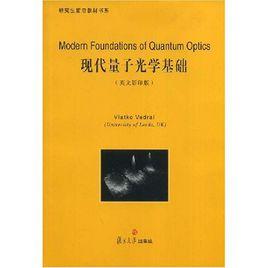圖書信息
出版社: 復旦大學出版社; 第1版 (2006年11月1日)
外文書名: Modern Foundations of Quantum Optics
叢書名: 研究生前沿教材書系
正文語種: 英語
ISBN: 7309052056
條形碼: 9787309052053
尺寸: 23 x 15.7 x 1.2 cm
重量: 299 g
作者簡介
作者:(英國)維特拉 (Viatko Vedral)
VlatkoVedral
英國Leeds大學終身教授,量子信息科學研究室主任。
1971年出生,英籍南斯拉夫裔科學家。1995年取得ImperialCollegeofScience,TechnologyandMedicine的理論物理學士學位,1998年在導師PeterL.Knight爵士的指導下,取得該校物理學博士學位,論文題目是“糾纏態的量子資訊理論”。同年進牛津大學從事博士後研究。2001年至2003年為牛津大學Keble學院的高級講師、帝國理工學院高級講師兼量子物理學科審稿人。主講量子力學、光學、數學、熱力學、統計力學、電磁學等多門課程,同時給博士後研究班開設《量子計算和量子光學》講座。這期間還到奧地利的維也納大學、加拿大的Waterloo大學、新加坡大學、維也納的Schr⒐dinger研究所、美國的普林斯頓大學做訪問教授。他是Nature,Phys.Rev.,Proc.Roy.Soc.,J.Mod.Opt.等雜誌的審稿人,也是英國皇家協會、奧地利科學基金會以及其他國際基金會的評審人,還是博士論文和研究人員職稱資格的評審人。在短短的6年時間裡,培養博士10名,發表量子光學、量子信息和量子物理的學術論文90多篇,單獨出版教材2本,合作出版著作3本。到世界各地講學100次,並經常接受媒體訪談,已成為英國學術界一顆耀眼的新星。
內容簡介
《現代量子光學基礎》是作者根據自己從2001年到2004年連續三年給Leeds大學物理系高年級學生講授量子光學的講稿整理而成的。這也是迄今為止對量子光學闡述得最全面、最新穎的教科書。通過干涉現象闡述光的本性是全書的核心。《現代量子光學基礎》由11章內容和5套練習及解答構成,分別就經典、舊量子論、半經典和完全量子力學四個層面闡述光與物質的相互作用、雷射的原理和套用、場的量子化以及量子光學的最新進展等等。《現代量子光學基礎》就雷射冷卻、玻色凝結、量子信息和傳輸等最新進展作了簡單易懂的介紹,難怪劍橋大學的ArturEkert教授作出了極高的評價:“我很難想到作者會用如此高超的辦法,把量子光學的那些最新的有趣的研究領域融入到量子光學的概念、方法和套用之中。很顯然,這是一本既透徹、又新鮮的教科書,這也是一本寫得特別清晰、充滿激情和細緻認真的書。作者把自己深厚的學術功底、透徹的論證推理和簡明易懂的表述風格和創造性的演繹融合在一起。我相信《現代量子光學基礎》一書,一定會引起包括初學者和專家在內的廣大讀者的關注。”
目錄
Preface
Acknowledgements
1.FromGeometrytotheQuantum
2.IntroductiontoLasers
2.1NormalModesinaCavity
2.2BasicPropertiesofLasers
3.PropertiesofLight:BlackbodyRadiation
3.1Planck'sQuantumDerivation
3.2TheProperDerivationofPlanck'sFormula
3.3FluctuationsofLight
3.4Maxwell'sLucifer
4.InteractionofLightwithMatterI
4.1StimulatedandSpontaneousEmission
4.2OpticalExcitationofTwoLevelAtoms
43Life-TimeandAmplification
5.BasicOpticalProcesses—StillClassical
5.1InterferenceandCoherence
5.2LightPressure
5.3OpticalAbsorption
5.4Amplification:ThreeLevelSystems
5.5ClassicalTreatmentofAtom-LightInteraction
5.5.1Dipoleradiation
5.5.2Radiationdamping
5.6SpectralLines
6.MoreDetailedPrinciplesofLaser
6.1BasicTheory:ClassicalElectrodynamics
6.2Mode-Locking
6.3Non-linearOptics
6.4PhaseMatching
6.4.1Rigorousderivation
6.4.2Heuristicderivation
6.5MultiphotonProcesses
7.InteractionsofLightwithMatterII
7.1VectorSpaces
7.2DiracFormalism
7.3TimeDependentPerturbationTheory
7.4AlternativeDerivationofPerturbation
7.5TheWigner-WeisskopfTheory
7.5.1Constantperturbation
7.5.2Harmonicperturbation
7.6Digression:EntropyandtheSecondLaw
7.7Einstein'sBCoefficient
7.8MultiphotonProcessesRevisited
8.TwoLevelSystems
8.1OperatorMatrixAlgebra
8.2TwoLevelSystems:RabiModel
8.3OtherIssueswithTwoLevelSystems
8.4TheBerryPhase
8.4.1Paralleltransport
8.4.2TheBlochsphere
8.4.3Implementation
8.4.4Generalizationofthephase
8.5GaugePrinciple
9.FieldQuantization
9.1QuantumHarmonicOscillator
9.2WhatArePhotons?
9.3BlackbodySpectrumfromPhotons
9.4QuantumFluctuationsandZeroPointEnergy
9.5CoherentStates
9.6CompositeSystems—TensorProductSpaces
9.6.1Beamsplitters
9.6.2Generationofcoherentstates
9.7BosonicNatureofLight
9.8Polarization:TheQuantumDescription
9.8.1Unpolarizedlight—mixedstates
10.InteractionofLightwithMatterIII
10.1FullyQuantizedTreatment
10.2Jaynes-CummingsModel
10.3SpontaneousEmission—AtLast
10.4TheLambShift
10.5ParametricDownConversion
10.6QuantumMeasurement:ABriefDiscussion
11.SomeRecentApplicationsofQuantumOptics
11.1LaserCooling
11.1.1Bose-Einsteincondensation
11.2QuantumInformationProcessing
11.2.1Quantumteleportation
12.ClosingLines
13.ProblemsandSolutions
13.1ProblemandSolutions1
13.1.1Problemset1
13.1.2Solutions1
13.2ProblemandSolutions2
13.2.1Problemset2
13.2.2Solutions2
13.3ProblemsandSolutions3
13.3.1Problemset3
13.3.2Solutions3
13.4ProblemsandSolutions4
13.4.1Problemset4
13.4.2Solutions4
13.5ProblemsandSolutions5
13.5.1Problemset5
13.5.2Solutions5
Bibliography
Index

